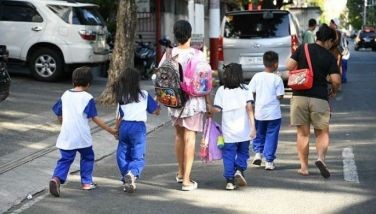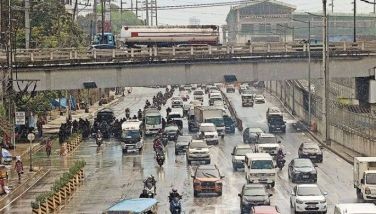‘10,000 dead, missing’
MANILA, Philippines - As many as 10,000 people are believed to have died in Tacloban City alone when one of the worst storms on record sent giant sea waves inland, washing away homes, schools and airport buildings, officials said yesterday.
Ferocious winds ravaged several islands in the Visayas, burying people under tons of debris and leaving corpses hanging from trees.
Regional police director Chief Superintendent Elmer Soria said Leyte Gov. Dominic Petilla told him late Saturday that there were about 10,000 deaths in the province, mostly by drowning and from collapsed buildings.
The governor’s figure was based on reports from village officials in areas which monster Typhoon Yolanda slammed Friday.
Tacloban city administrator Tecson Lim said the death toll in the city alone “could go up to 10,000.†Tacloban is the provincial capital of Leyte with a population of around 200,000.
The estimate was way higher than the official count of the National Disaster Risk Reduction and Management Council (NDRRMC), which stood at 229 as of 7 p.m. yesterday.
The NDRRMC refused to comment on the reports.
“We are not confirming it,†NDRRMC spokesman Maj. Rey Balido said when asked for comment.
“We do not know where the figure came from. We are relying on the reports we received from our field units.â€
The NDRRMC said most of the fatalities were from Eastern Visayas, composed of Samar and Leyte provinces.
Eight fatalities were recorded in Western Visayas, four in Mimaropa, two in Calabarzon, and one each in Bicol, Zamboanga peninsula and Caraga region.
A total of 45 people were injured while 28 others went missing.
However, in Samar, Leo Dacaynos of the provincial disaster office said yesterday that 300 people were confirmed dead in Basey town and another 2,000 are missing.
Dacaynos said the storm surge caused sea water to rise six meters when Yolanda hit Friday, before crossing to Tacloban.
There are still other towns in Samar - with a total population of around 733,000 - that have not been reached, he said, as he appealed for food and water.
Power was knocked out and there was no cellphone signal, making communication possible only by radio.
Reports of dozens of fatalities from the other four islands were still coming in.
Iloilo Vice Gov. Raul Tupas yesterday reported 48 fatalities with some 225,000 people left homeless by the typhoon.
Tupas said their initial assessment showed up to 90 percent of the houses in the coastal areas in Iloilo were destroyed.
He said the city of Iloilo posted a total of 48 casualties, including 30 people from Estancia town, one of the coastal areas in the province. A total of 80,000 families or 225,000 people were displaced as their homes were damaged or totally washed away by the typhoon.
“The casualties from Estancia were fisherfolks who drowned to death when their boats capsized during a storm surge,†Tupas said.
Yolanda barreled through Visayas region on Friday, wiping away buildings and leveling seaside homes with ferocious winds of 235 kilometers per hour and gusts of 275 kph. By those measurements, Haiyan would be comparable to a strong Category 4 hurricane in the US, and nearly in the top category, a 5.
The typhoon weakened yesterday to 166 kph but with stronger gusts and was forecast to lose strength further when it hits northern Vietnam early today.
In hardest-hit Tacloban, about 300-400 bodies have already been recovered but there are “still a lot under the debris,†Lim said.
A mass burial was planned Sunday in Palo town near Tacloban.
Many corpses hung on tree branches, buildings and sidewalks.
“On the way to the airport we saw many bodies along the street,†said Philippine-born Australian Mila Ward, 53, who was waiting at the Tacloban airport to catch a military flight back to Manila.
“They were covered with just anything - tarpaulin, roofing sheets, cardboards,†she said. Asked how many, she said, “Well over 100 where we passed.â€
One Tacloban resident said he and others took refuge inside a parked jeepney to protect themselves from the storm, but the vehicle was swept away by a surging wall of water.
“The water was as high as a coconut tree,†said 44-year-old Sandy Torotoro, a pedicab driver who lives near the airport with his wife and 8-year-old daughter.
“I got out of the jeep and I was swept away by the rampaging water with logs, trees and our house, which was ripped off from its mooring.
“When we were being swept by the water, many people were floating and raising their hands and yelling for help. But what can we do? We also needed to be helped,†Torotoro said.
In Torotoro’s village, bodies could be seen lying along the muddy main road, as residents who had lost their homes huddled, holding on to the few things they had managed to save. The road was lined with trees that had fallen to the ground.
‘All are down’
Interior and Local Government Secretary Manuel Roxas II said a massive rescue operation was underway.
“We expect a very high number of fatalities as well as injured,†Roxas said after visiting Tacloban on Saturday.
“All systems, all vestiges of modern living - communications, power, water - all are down. Media is down, so there is no way to communicate with the people in a mass sort of way.â€
President Aquino, who flew to Tacloban yesterday to get a firsthand look at the disaster, admitted the casualties “will be substantially more†than the official count of 151 - but gave no figure or estimate.
Aquino said the government’s priority was to restore power and communications in isolated areas to allow for the delivery of relief and medical assistance to victims.
The Department of Health (DOH) is seeking the assistance of the private sector in addressing the medical needs of the growing number of typhoon-affected people from the Eastern Visayas.
DOH spokesman Dr. Eric Tayag said they asked doctors and nurses from private medical facilities to join the medical missions.
Tayag appealed to drug companies to donate medicines.
Health Secretary Enrique Ona flew to Tacloban yesterday to assess the situation and determine the necessary assistance needed.
Social Welfare Secretary Corazon Soliman also went to Tacloban to personally supervise the distribution of relief goods.
“The relief operations are hampered by lack of communication and inaccessibility of the worst-hit towns, cities and barangays, but we from DSWD (Department of Social Welfare and Development) and other government agencies are doing our best to reach the affected population,†Soliman said.
The DSWD reported the number of families and people affected by the typhoon has reached 9.53 million people from about 2.1 million families spread out in eight regions in Luzon, Visayas and Mindanao.
The NDRRMC said 630,054 individuals or 132,323 families were displaced.
Some 447,675 individuals or 95,696 families are now staying inside 1,645 evacuation centers.
As of yesterday morning, the NDRRMC reported the amount of property damage caused by the typhoon was pegged at P138.55 million.
Agriculture accounted for P124.76 million of the damage and infrastructure P13.8 million.
The typhoon has damaged a total of 19,551 houses in Calabarzon, Western Visayas, Eastern Visayas, Northern Mindanao, Davao and Caraga regions but this could rise further as reports from other affected regions come in.
A total of three roads remain impassable in Western and Eastern Visayas.
The bad weather also caused the suspension of operations of airports in Busuanga, Roxas, Kalibo and Tacloban.
State agencies and local governments have provided P10.64 million worth of relief assistance to affected families.
The airport in Tacloban, on the other hand, looked like a muddy wasteland of debris, with crumpled tin roofs and upturned cars.
The airport tower’s glass windows were shattered, and air force helicopters were busy flying in and out at the start of relief operations. Residential homes that had lined up a 7-kilometer stretch of road leading to Tacloban city were all blown or washed away.
The winds were so strong that Tacloban residents who sought shelter at a local school tied down the roof of the building but it was still ripped off and the school collapsed, Lim said. It wasn’t clear how many died there.
“The devastation is, I don’t have the words for it,†Roxas said. “It’s really horrific. It’s a great human tragedy.â€
Defense Secretary Voltaire Gazmin said Aquino was “speechless†when he told him of the devastation the typhoon had wrought in Tacloban.
“I told him all systems are down,†Gazmin said. “There is no power, no water, nothing. People are desperate. They’re looting.â€
The city’s two largest malls and groceries were looted and the gasoline stations destroyed by the typhoon. Police were deployed to guard a fuel depot to prevent looting of fuel.
Yesterday, the city’s overwhelmed services were reinforced by 100 special police force units sent in from elsewhere to help restore peace and order.
Vice Mayor Jim Pe of Coron town on Busuanga, the last island battered by the typhoon before it blew away to the West Philippine Sea, said most of the houses and buildings there had been destroyed or damaged. Five people drowned in the storm surge and three others were missing, Pe said by phone.
“It was like a 747 flying just above my roof,†he said, describing the sound of the winds.
Pe said his family and some of his neighbors whose houses were destroyed took shelter in his basement.
In the aftermath of the typhoon, people were seen weeping while retrieving bodies of loved ones inside buildings and on a street that was littered with fallen trees, roofing material and other building parts torn off in the storm’s fury. All that was left of one large building whose walls were smashed in were the skeletal remains of its rafters.
Tim Ticar, a local tourism officer, said 6,000 foreign and local tourists were stranded on the popular resort island of Boracay, one of the tourist spots in the typhoon’s path.
Transport by land
An Waray party-list Rep. Niel Montejo said yesterday relief goods could be transported to Tacloban City by land through the San Juanico bridge.
In a message relayed to Speaker Feliciano Belmonte on the phone, Montejo confirmed “that there is hardly food and water for the people in Tacloban City.â€
He said tents are also needed as sleeping quarters.
However, the more serious problem in the city is peace and order as people continue to loot stores for food and water and other supplies, he said.
He said local police have to be augmented to tighten security in the area.
Belmonte said Montejo had talked with Interior Secretary Roxas, stressing that police deployment is immediately needed.
The Speaker said he would call congressmen in typhoon affected provinces to discuss today assistance which could be extended to them.– AP, Alexis Romero, Mayen Jaymalin, Rainier Allan Ronda, Paolo Romero
- Latest
- Trending




























